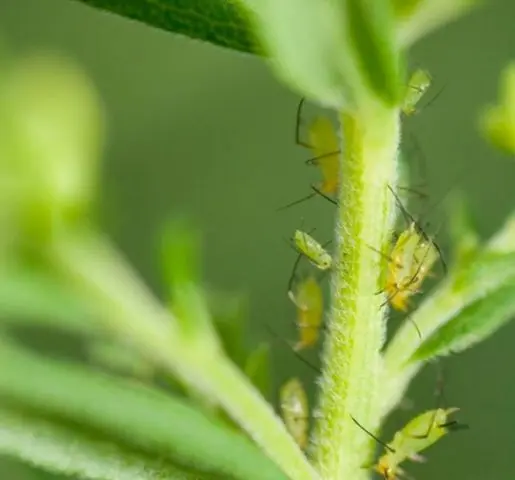Contents
Growing salpiglossis, a showy lush flowering herbaceous plant native to South America, is becoming more and more popular every year in home gardens. This is not surprising: the large trumpet-tongued corollas, which look like a bell and a petunia at the same time, look bright and unusual due to the original color of the petals with a thin mesh pattern that creates the effect of a mother-of-pearl overflow. In ornamental culture, only one type of plant is used, but a significant number of varieties and hybrids have been bred on its basis. They differ in the color and size of the flowers, the height of the plant bush, the degree of branching of the shoots.
You can grow salpiglossis seedling method or sow the seeds directly in open ground. This plant is not capricious, it does not require too complicated and troublesome care. But the bright, exotic beauty of the pipe-tonguer will surely make it a real gem of any, even the richest and most sophisticated garden collection.
General description of salpiglossis
The genus Salpiglossis belongs to the Solanaceae family and unites about 20 species of herbaceous flowering plants. Among them there are both perennials and those whose life cycle lasts only 1 or 2 seasons.

In horticulture, the only type of salpiglossis is used – notched
В дикой природе сальпиглоссис можно встретить в горах Аргентины, Чили и Перу. В культуру он введен сравнительно недавно – в начале ХХ века в США.
The root system of salpiglossis is of mixed type. It has a well-defined main root and developed adnexal. The stems of the plant are thin, vertical, most often branched, although there are also single straight ones. Their height varies widely from 15 to 100 cm. The surface of the shoots of the plant is evenly covered with glandular villi, which may seem sticky to the touch.
The oblong-elongated leaves of salpiglossis, depending on the species, may have a solid, serrated or pinnate edge. They are in sequential order. The leaf blades of the plant in the basal and central parts of the stem are equipped with petioles, while in the upper they are sessile.
Salpiglossis flowers are solitary, located on the tops of the shoots. They appear in early summer and decorate the plant until the first October frosts. The flowers are very large (4-6 cm in diameter), bright, very decorative. The corolla of the plant is funnel-shaped and consists of 5 blades with a delicate, velvety surface. The color of salpiglossis flowers is very diverse. It can be white, yellow, red of any shades, purple, purple, dark blue. On the inner surface of the petals there is a thin, clearly visible contrasting pattern of golden or dark veins, which makes the flowers of this plant especially attractive.

The color of salpiglossis flowers fascinates with a combination of shades, and the inner surface of the petals, thanks to a pattern of thin veins, shimmers in the light like mother of pearl
The fruit of salpiglossis is a small oval box with two compartments. Inside it, at the end of flowering, the plant ripens small seeds.
Types and varieties of salpiglossis with names and photos
In ornamental gardening, the only species of this plant is grown – the annual notched salpiglossis (in Latin Salpiglossis sinuata). Within its framework, three varieties are distinguished: large-flowered, superbissima and low. Currently, all kinds of hybrid plant varieties are also very popular.
Salpiglossis notched large-flowered (var. grandiflora)
This variety of notched salpiglossis is characterized by high (90-100 cm) bushes. The stems of the plant are strongly branched and abound in large flowers.
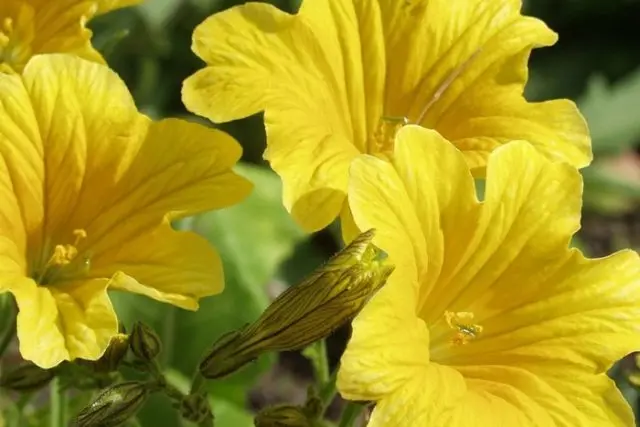
The large-flowered variety of salpiglossis has tall bushes and strongly branching shoots.
Warning! Tall varieties of salpiglossis growing in an open area, without fail, need support. It will be enough to stick an ordinary peg into the ground, tying the shoots of the plant to it with twine.
Salpiglossis notched Superbissima (var. superbissima)
The stems of Salpiglossis Superbissima have an average height (no more than 60 cm). The flowering shoots of this plant are solitary, branching is absent. The inflorescences are large, and the petals have characteristic corrugated edges. Salpiglossis Superbyssima seeds are usually sold as a mixture. From one bag you can grow flowers of various colors.
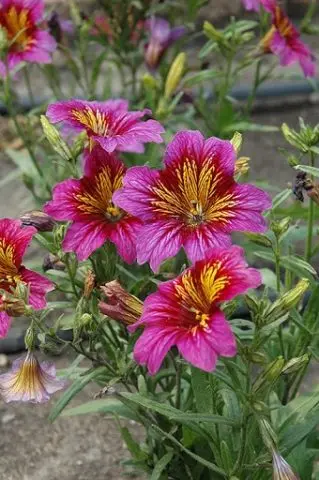
The shoots of Salpiglossis Superbyssima do not branch, and the petals of the plant have a slightly corrugated edge.
Сальпиглоссис выемчатый низкий (var. nanus)
The smallest variety of notched salpiglossis (from 15 to 40 cm). Numerous thin stems of the plant are densely branched. The flowers are smaller than the other two varieties, but a large number of them are tied. Lush and bright, but at the same time compact low salpiglossis bushes are ideal for decorating a limited space – a balcony, loggia, terrace – when growing a plant in flowerpots or containers.

Сальпиглоссис низкий отлично подходит для выращивания в контейнерах и горшках
Royale (Royal) F1
A hybrid plant variety, noted and recommended by the Royal Horticultural Society of Great Britain. Combines compact bushes of salpiglossis (40-60 cm in height) with abundant branching shoots and large flowers.
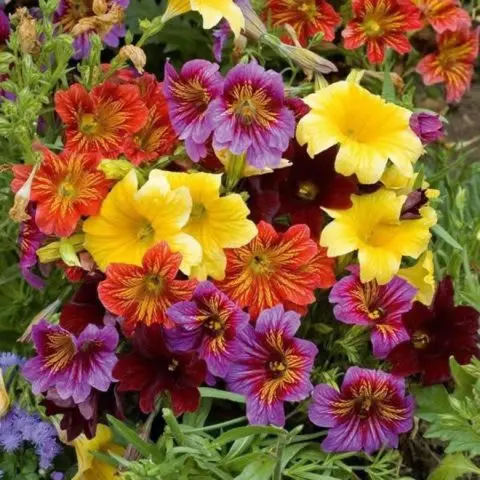
Plant Royale Yellow (Royal Yellow) is distinguished by sunny yellow inflorescences
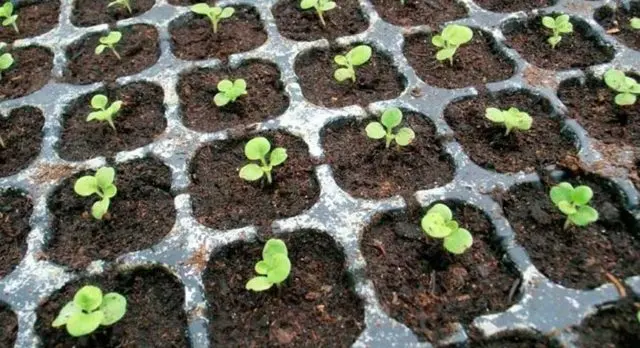
The velvety petals of Royale Chocolate (Royal Chocolat) are unique in their wine-burgundy color
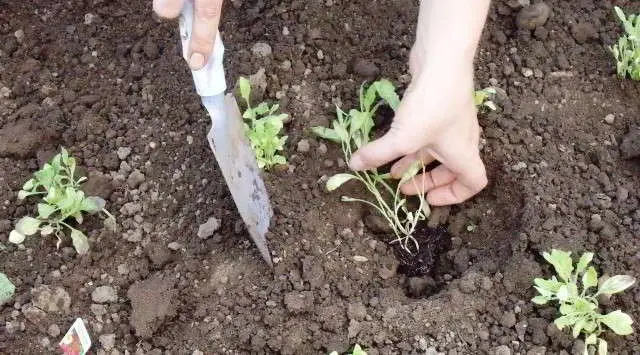
Flowers Royale Purple Bicolor (Royal Purple Bicolor) shimmer purple and gold
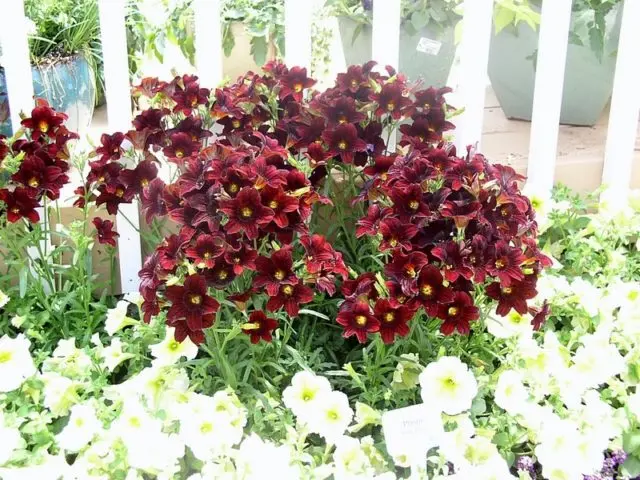
Окрас венчиков Royale Red Bicolor (Ройал Ред Биколор) отличается гармоничным сочетанием красного с золотым
Kew Blue F1
Hybrid low salpiglossis from 30 to 45 cm tall. The corollas of the plant are colored in rich indigo, and their central region is a darker, blue-violet color. A thin network of golden veins on the petals is almost invisible, but in the light it contributes to the manifestation of “mother-of-pearl” overflows. This hybrid is very often grown in winter gardens and greenhouses.

Kew Blue pleases the eye with pearly tints of blue-violet color
Casino Mix F1
This salpiglossis reaches 45-60 cm in height. The flowers of the plant are painted in all sorts of combinations of tones and shades: purple with gold, orange-ocher, dark red with pink, pale lilac with burgundy. Hybrid Casino Mix is often used for border decoration or growing in pots and containers. Adult plants are recommended to organize additional support.
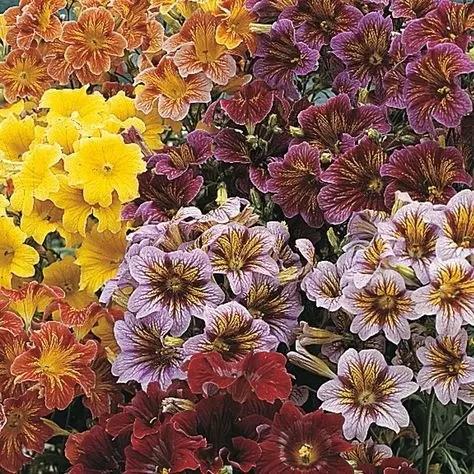
From a bag of seeds Casino Mix you can get a whole palette of colors
Bolero (Bolero)
The height of the bushes of this hybrid variety reaches 40-60 cm. The stems of the plant are strongly branched. The flowers are relatively small (6-7 cm). The colors of its corollas combine a variety of shades of red, yellow, purple. Salpiglossis Bolero grows well in full sun and partial shade.

Среднерослый яркий Болеро станет превосходным оформлением бордюров и дорожек
Ali Baba (Ali Baba)
Hybrid of selection. Tall (70-80 cm), well-branching salpiglossis with large flowers of bright, saturated colors and contrasting, clearly visible veins. The plant looks great in the cut. It is recommended to pinch the tops of the flowering shoots of the Ali Baba variety for their best branching.
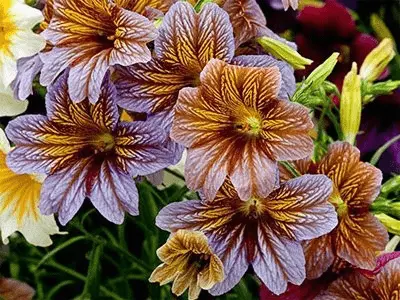
large-flowered hybrid of Salpiglossis Ali Baba looks great in bouquets
Application in landscape design
The possibilities of using salpiglossis in landscape design are truly inexhaustible. The examples below are just some of the ways you can use this showy, vibrant flowering plant to decorate your backyard:
- group mono-plantings, which combine salpiglossis of various varieties;
- color accent in multi-level compositions with a delicate background of silvery cinneraria, Schmidt’s wormwood, cypress santolina;
- design of borders and paths;
- bright, colorful flower beds in combination with annual plants: petunias, salvia, nasturtium, marigolds;
- посадка рядом с хвойными кустарниками и деревьями, способными подчеркнуть яркость и экзотическую красоту сальпиглоссиса;
- various compositions with other flowering plants: chrysanthemums, daylilies.
Low-growing varieties of salpiglossis excel as a pot culture, decorating balconies, terraces, winter gardens.
When cut, these plants look wonderful in bouquets and stay fresh for a long time.
Features of reproduction
Salpiglossis propagates by seeds. In the southern regions with a warm and mild climate, winter or spring sowing of this plant directly into the ground is usually practiced. In areas with more severe weather, salpiglossis seedlings are pre-grown. Strengthened seedlings of the plant are planted in an open area with the onset of stable heat.
Growing salpiglossis flower from seeds
The optimal time for sowing salpiglossis seeds for seedlings is the end of March or mid-April.
For this, it is best to prepare wide, shallow containers (containers or plastic trays) with a sufficient number of drainage holes in the bottom. You can use individual cups or small pots, in which case subsequently the seedlings of salpiglossis will not need to dive. A good solution for the seeds of this plant will also be peat tablets.

Seeds of salpiglossis are conveniently sown immediately for seedlings in individual containers in order to subsequently avoid diving.
The soil for growing seedlings of salpiglossis must meet the following requirements:
- loose, light;
- nutritious;
- neutral or slightly acidic.
You can buy a potting mix suitable for this plant, but it is not at all difficult to prepare it yourself. You need to mix:
- 2 parts of sod land;
- 1 part river sand;
- 0,5 parts wood ash.
Sowing seeds of salpiglossis is done as follows:
- На дно емкостей насыпают небольшой слой дренажа (керамзита, мелкой гальки, пенопластовой крошки).
- Top fill containers with soil.
- Moderately moisturize it by spraying with warm water from a spray bottle.
- Равномерно раскладывают по поверхности грунта семена растения. Если для посева сальпиглоссиса выбраны индивидуальные емкости, то в каждую из них следует поместить по 2-3 штуки.
- Burying seeds is not allowed. They are only slightly pressed to the surface of the soil.
- Spray crops from a spray bottle.
- Cover the containers with transparent film or glass and place in a warm, moderately lit place.

Immediately after sowing, the seed container will need to be covered with foil, placed on a window in a warm room and shaded by laying a sheet of white paper on top of the “greenhouse”
Care of seedlings
The basic rules for caring for seedlings of salpiglossis from the moment the seeds are sown until the young plants are planted in the ground are as follows:
- Providing a moderate amount of diffused light. When placing a “greenhouse” with seedlings of salpiglossis on a sunny windowsill, at first you will need to cover it on top with a sheet of white paper. 15-20 days after the emergence of seedlings, the plants begin to illuminate them with a phytolamp, bringing the daylight hours to 12-14 hours.
- Maintaining a stable warm temperature. The optimal mode is about + 20 ° С.
- Regular moistening of the soil with settled water at room temperature. It is produced as needed, making sure that the substrate at the roots of the plants does not dry out. In order to avoid the accumulation of excess moisture, salpiglossis seedlings should be watered with caution, ideally by spraying the soil with a spray bottle.
- Daily ventilation of crops. Shelter from the film should be removed for 10-15 minutes from the first days of plant life, at the same time removing droplets of condensate that have accumulated on its inside. A couple of weeks after the salpiglossis seeds germinate, the time they spend in the fresh air outside the “greenhouse” is gradually increased. Subsequently, the shelter is removed completely.
- Пикировка сеянцев растения производится после появления у них первой пары настоящих листочков. Кустики сальпиглоссиса аккуратно переносят по одному в индивидуальные емкости вместе с комом земли на корнях. Если при посеве семян были использованы стаканчики или горшочки, то пикировать рассаду не требуется. Достаточно будет аккуратно удалить слабые растения, оставив в каждой емкости по одному самому развитому и крепкому.
- Gently pinching the tops will help the Salpiglossis bushes branch better. After picking seedlings and before transferring them to a permanent place in open ground, this procedure is performed 2-3 times.
- It is highly desirable to install a support for each plant after picking. This will help thin stems not to break under the weight of developing leaves.
Transplant into the ground
Planting seedlings of salpiglossis in open ground is carried out from mid-May. A prerequisite is the absence of return frosts and a consistently warm air temperature of about + 10 ° С.

In mid or late May, seedlings can be transplanted into open ground.
A couple of weeks before the planned transplant, prepare the site. This is done according to the same rules that are relevant before sowing plant seeds directly into open ground. On the eve of planting seedlings, the earth must be dug up again.
Seedlings of salpiglossis are transferred to holes prepared in the ground by transshipment of plants along with a clod of earth on the roots, observing a step of 25-30 cm. They are watered with a small amount of water, supports for the stems are organized and the soil at the roots is mulched with herbal compost.
Planting salpiglossis seeds in the ground
If the climate allows, you can not bother with growing seedlings, but sow the seeds of the trumpet tongue directly into the soil in the garden. This method is undoubtedly simpler, but it is worth remembering that the flowering of salpiglossis in this case will come later – in the second half of summer.
Deadlines
The seeds of this plant are usually planted in open ground in late April or early May. Sometimes winter sowing is practiced, in October, but it is not very common. It often happens that the seeds of a tropical beauty do not germinate after the winter cold.
Site selection and preparation of soil
The area where salpiglossis is to grow should be selected according to the following criteria:
- well lit by the sun;
- protected from drafts and strong gusts of wind;
- with light, fertile, well-drained soil.
It is desirable that the bed is located on a small hill.
За 10-15 дней до посева семян сальпиглоссиса грунт на грядке качественно перекапывают на глубину штыка лопаты с добавлением комплексного минерального удобрения. Если почва слишком кислая, дополнительно вносят доломитовую муку или золу. Тяжелые, глинистые, бедные грунты разбавляют песком, торфом, перегноем.
Landing algorithm
Посев семян сальпиглоссиса в открытый грунт желательно выполнять в солнечный день, когда не ожидается ни тумана, ни дождя.
The process goes like this:
- On the prepared site, grooves are laid about 2-2,5 cm deep, or holes for individual planting, maintaining a distance between them of 25-30 cm.
- The seeds of the plant are evenly laid out in them, without deepening them.
- Sprinkle on top with a thin layer of soil.
- Abundantly watered.
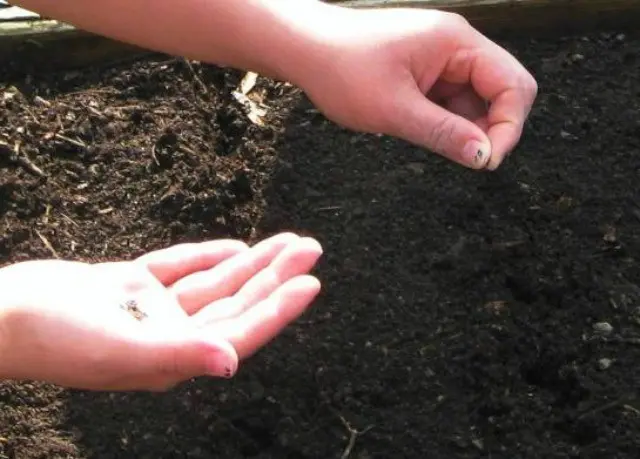
In a warm mild climate, you can sow seeds in a seedless way – directly into open ground
Under all conditions, sprouts will appear in 14-20 days. If they have risen too densely, they will need to be thinned out, leaving the strongest and strongest specimens in the ground. It is necessary that the distance between plants is 25-30 cm.
Правила выращивания в открытом грунте
Care for salpiglossis growing in the open field is simple. The set of measures described below will help maintain the health and beautiful flowering of the plant.
Watering and fertilizing schedule
Watering salpiglossis in the open field should be regular. It is advisable to use settled water at room temperature for the procedure. It is necessary to ensure that the soil under the salpiglossis bushes does not dry out, as it does not tolerate a lack of moisture. At the same time, excessive moisture and stagnant water in the soil are also dangerous: they can cause the plant to develop root rot.
In spring and autumn, it is enough to water salpiglossis a couple of times a week. In hot summer, the frequency of procedures should be increased to 1 time per day, and in the evenings, additionally spray the plants.
Salpiglossis responds well to top dressing. The recommended frequency of fertilizing the soil is twice a month. It is advisable to alternate organic compounds with mineral ones. The introduction of the latter is especially important at the stage of active flowering of the plant, in June-July, as it has a positive effect on its duration and beauty.
Loosening and mulching
Loosening the soil under salpiglossis is done every time after watering or heavy rain. It is necessary to perform the procedure very carefully so as not to damage the roots of the plant. The depth of loosening should not exceed a few centimeters.
After the soil is slightly dry, it is recommended to mulch it. This will help to better retain moisture at the roots of the plant, and will also prevent the growth of weeds. As a mulch for salpiglossis, natural materials are best suited: sawdust, peat, chopped straw. Its layer should not be thick – 1 cm is enough.
Shrub formation
To maintain the beautiful shape of the salpiglossis bush, pinching the central shoots of the plant will help. This procedure contributes to their better branching and the appearance of a large number of flower buds. For the first time, pinching of salpiglossis is performed even at the seedling stage, and when sowing in open ground, when the height of young plants reaches 10 cm. Then the procedure is repeated several times during the season.

Pinching the central shoots will help form a beautifully branching and abundantly flowering bush.
Rules for care during the flowering period
During the flowering period, which lasts 3-4 months, care for salpiglossis in the open field is supplemented by the regular removal of faded buds. This will help the plant not waste nutrients, directing them to the drying inflorescences. It is also necessary to remove diseased and rotten twigs and leaves in a timely manner, which will help preserve the beautiful decorative appearance of the bush.
In addition, during this period, it is important to adhere to the regime of watering and fertilizing the plant with special care, regularly weed out the weeds near the salpiglossis plantings and, if necessary, provide support for its shoots.
Wintering
In areas with a cold climate, salpiglossis is grown as an annual plant.
In regions with milder and warmer weather, you can try to let him winter indoors. To do this, with the onset of autumn, the salpiglossis bush is transplanted into a deep pot with a layer of drainage at the bottom, filled with light, loose soil. The wintering plant is placed on the western or southwestern window of the apartment, organizing a moderate amount of diffused light for it. The temperature in the room should be maintained at + 18-20 °C. If the room is warmer, it is necessary to regularly ventilate it, while making sure that there are no drafts.
Diseases and pests
Salpiglossis is a plant that is resistant to most diseases and pests. Among the problems that can harm his health, primarily the following:
- Fungal diseases. First of all, this is the root rot of the plant, less often – late blight, powdery mildew, fusarium. Most often they appear on salpiglossis in the hot, but rainy season, or when the irrigation regime is violated, when the soil becomes waterlogged and water stagnates at the roots. Rotting of the underground part of the plant is accompanied by stunting, rapid yellowing and wilting of the foliage, blackening of the stems. Pruning and destruction of diseased plant organs will help to cope with fungi (in case of severe damage to the roots, disposal of the entire bush), the use of chemical fungicides containing copper – such as Ridomil, Skor, Topaz, Bordeaux mixture. It is necessary to correct the mistakes made when watering salpiglossis.

Fungal diseases, in particular root rot, can occur on the plant due to excess moisture in the soil.
- Aphid. Colonies of these rapidly multiplying parasites settle in the axils of the leaves of salpiglossis, then move to the buds, actively feeding on the juices of the plant. The bushes weaken, the foliage turns yellow and curls, which is why the decorative effect of the flower garden suffers significantly. To combat aphids on salpiglossis, folk methods are used (spraying plants with soapy water, decoctions of citrus peels, garlic, tobacco leaves, onion husks) and chemicals (Decis, Fitoverm).

Aphids feed on plant sap, which can significantly slow down their growth and development.
Conclusion
Growing salpiglossis on a personal plot is not very difficult. If the choice was made in favor of the seedling method, you will have to work a little while caring for the seedlings growing in a mini-greenhouse on the window. But with the onset of a warm spring, it will be possible to plant the grown bushes of salpiglossis on the garden bed, without fear that they will not sprout or freeze. It is even easier to sow seeds directly into open ground. However, this option is only suitable for regions with a mild warm climate. In any case, it is worth growing salpiglossis in your own garden, because having appeared in culture relatively recently, it has already managed to rightfully win love and recognition among those who prefer plants that bloom for a long time, luxuriantly and brightly. A rich selection of varieties and hybrids of salpiglossis makes it possible to show imagination without restrictions, creating colorful flower beds and compositions on the site.











